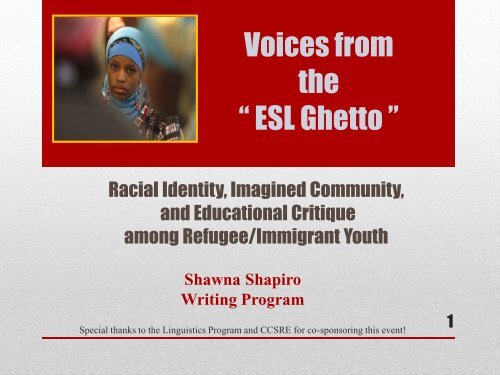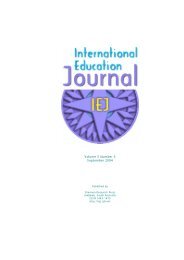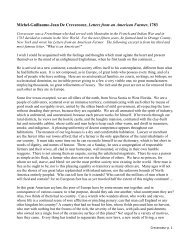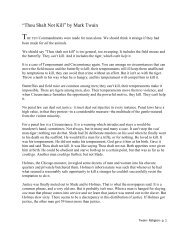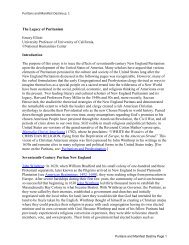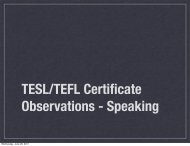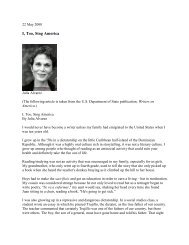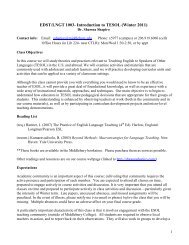ESL as “GHETTO” - Shawna Shapiro
ESL as “GHETTO” - Shawna Shapiro
ESL as “GHETTO” - Shawna Shapiro
You also want an ePaper? Increase the reach of your titles
YUMPU automatically turns print PDFs into web optimized ePapers that Google loves.
Voices fromthe“ <strong>ESL</strong> Ghetto ”Racial Identity, Imagined Community,and Educational Critiqueamong Refugee/Immigrant Youth<strong>Shawna</strong> <strong>Shapiro</strong>Writing ProgramSpecial thanks to the Linguistics Program and CCSRE for co-sponsoring this event!1
The imagined community of an <strong>ESL</strong> cl<strong>as</strong>s…2
<strong>ESL</strong> <strong>as</strong> shelter??3
Sheltered <strong>ESL</strong> courses• Teach content, language, and skillsmath, science, language arts, social studies• Can be used in mainstream or in “pull-out” cl<strong>as</strong>sesPull-out model…• May not parallel grade-level curriculum in mainstream• May not fulfill high school graduation requirements• May be marked <strong>as</strong> “<strong>ESL</strong>” on high school transcripts• May be difficult to switch “tracks” from sheltered to mainstream(and eventually honors/college prep) courses4
My current workInterviews with ELLs in Vermontabout transitioning from high school to collegeo What h<strong>as</strong> helped you progress linguistically, academically,socially in school? (<strong>ESL</strong> cl<strong>as</strong>ses?)o When, why, how did you decide to go to college?o What do you wish you’d known/done in high school, to preparefor college?5
Then this happened….Student Protest at BHSApril 19, 2012 6
Students meet with reportersand a week later with state legislators 7
What caught my attention?• “There w<strong>as</strong> a sense conveyed by students that they were beinghemmed into ELL cl<strong>as</strong>ses without a chance to fully participate in thelife of the school.” (BFP report, 4/20/12)• “These students do not understand why they are isolated in cl<strong>as</strong>sesfrom the other students. They want to be part of the whole studentbody.” (BFP editorial, 4/26/12)• [Students] said too often they are segregated into English-<strong>as</strong>-<strong>as</strong>econd-languagecl<strong>as</strong>ses and are discouraged from rising to higherlevelcl<strong>as</strong>ses. (BFP report, 4/27/12)• “You don’t need to separate us. We are all equal” (student protester)Are <strong>ESL</strong> cl<strong>as</strong>ses seen <strong>as</strong> contributing to racism at BHS?8
Research questionsFrom the perspective of some students…How are <strong>ESL</strong> cl<strong>as</strong>ses linked toinstitutionalized racism? What do <strong>ESL</strong> cl<strong>as</strong>ses (and the “ELL” label itself) representfor students? Where is the mismatch between the intent of the cl<strong>as</strong>ses, andstudents’ lived experience? What does this suggest for education reform and for futureresearch?9
Conceptual FrameworkSchools and Symbolic Capital (Bourdieu)• Schools are sites of cultural/social reproduction• Students expect to gain cultural and linguistic capital from school(What do I need to “get ahead”?)-knowledge, cultural norms, prestige, the language of powerIdentity and Investment (Norton)• Investment in language learning is tied to perceived gain incultural and linguistic capital• Identity (present and future) shapes this perceptiono Who am I? (and do I belong in this community?)o Who do I want to be? (and will this help me get there?)“What h<strong>as</strong> not yet happened in the future can be a re<strong>as</strong>on and motivationfor what learners do in the present.” (Kanno & Norton, 2003, p. 248) 10
From previous studies…Valenzuela• Subtractive schooling (deficit-orientation)• Student resistanceValdés• Hyper-segregation• “<strong>ESL</strong> ghetto”Ibrahim• Immigrant students “becoming black”Bigelow• Somali youth• Limiting vs. unlimiting educational practices11
Context: City of Burlington• 40,000 residents—largest and “most diverse” city in Vermont• 93% white• Refugee resettlement starting in late 1980s, but acceleratedsince late 1990s~300 each year• 1 st wave: Bosnian, Vietnamese• 2 nd wave (since 2000): Somali, Congolese, Bhutanese, Burmese,Sudanese, IraqiSources: Burlington School District, Burlington Free Press,USCRI (February 2011 data),12
Context: BSD and BHSBurlington School District (BSD)4000+ students total• 72% White; 13% Black; 8% Asian;3% Hispanic; 4% multiracial• 17% ELLs (# more than doubled in p<strong>as</strong>t 10 years)Burlington High School (BHS)1100 students total• Similar profile for race/ethnicity• 14% ELLs• Both newcomers and long-term (5 or more years )Source: Burlington School District 13
Data Sources• News articles (N=12)(Burlington Free Press, VPR, Seven Days)• Video (BSD events on CCTV 17; independent footage)• Student Interviews (N=17, ~1 hour, semi-structured)• Participant Observation (committee meetings, etc.)14
MethodsCoding of data• <strong>ESL</strong> (ESOL/ELL) or sheltered cl<strong>as</strong>ses• Segregation, isolation, etc.• Racism, discrimination, etc.Triangulation with other data• Related newspaper articles and radio segments• Other interviews (faculty/staff)• Participant observation (notes, institutionaldocuments, etc.)15
Thread #1: Deficit LabelingAfrican; Refugee; International; New American; Black“African” comes to mean…“Other”o Show us “your” food, clothes, dances, religion etc.o “Tell us ‘your story’” (again and again!) “pobrecito syndrome”Inferioro illiterate, uneducated, not smart (“dirty,” “stinky,” “smelly,” “dumb”)o “They think we don’t know anything. But we do!” (student interviewee)“African ELL” becomes one more deficit labelooLimited English Proficiency (“Miss, Do YOU speak any other languages?”)Test scores make the labels stick (“We are bigger than test scores!”)16
Thread #2: Social isolation <strong>as</strong> detriment• “When you have people that speak the same language, and you have them inthe same cl<strong>as</strong>s, they won’t improve. Their English stays the same. Nothingwill change in their life. That’s a w<strong>as</strong>te of time for them.” (studentinterviewee)• “Teachers need to have other kids to be in different cl<strong>as</strong>ses so we could learn.”(student in reporter meeting)• “These students do not understand why they are isolated in cl<strong>as</strong>ses from theother students. They want to be part of the whole student body.”(BFP editorial, 4/26/12)• Sports were what “helped me make quick friends. That improved my English,made me social.” (student interviewee)17
Thread #3- Holding back (not pushing forward)• Sometimes they’d put me in an <strong>ESL</strong> cl<strong>as</strong>s that w<strong>as</strong> a little bit lower than I think Ishould be in…but they wouldn’t move me into a higher one…I got frustratedsometimes…I’m just saying, maybe I should get pushed a little harder” (studentinterviewee)• “Rewards, going up to higher levels, really pushed me.” (student, CCTV)• “They’re telling kids ‘You’re not college material!’” (community activist, CCTV)• “They don’t want to push them.” (parent interviewee, also a college student)• “Too many students are being placed in sheltered ELL cl<strong>as</strong>ses at Burlington HighSchool when they can handle mainstream cl<strong>as</strong>ses, [former ELL teacher] said.‘Make accommodations, but do not hold them back,’ she said. ‘We are teachers;it's our job to launch them <strong>as</strong> far <strong>as</strong> possible.’” (BFP report, 8/16/12)18
Thread #4: “What about my dreams?”• “Do you guys accept us…that we’re different, that we’re here, and we’reactually trying to succeed? …We came here to have success in life!” (studentin reporter meeting)• “They need to make us understand about the future and stuff…What are thesteps? We don’t know how to go through, what to do, what to make to besomebody.” (student interviewee)• “I’m gonna just say, this is about making family….If you bring all kidstogether and you’re telling them that ‘This is what we can do… This what youneed to be. We want you to have a family, a future, and we’ll be working hardon you…’ But I just feel like, sometimes, people maybe they want to havemore janitors in here, you know?”(student interviewee)• “The students say they feel they are being denied educational opportunityb<strong>as</strong>ed on who they are, rather than their abilities.” (BFP editorial, 6/20/12)19
Escaping the “<strong>ESL</strong> Ghetto”“The students, all immigrants from African countries,talked of offensive comments other students make in thehallways and that go unpunished. They said too oftenthey are segregated into English-<strong>as</strong>-a-second-languagecl<strong>as</strong>ses and are discouraged from rising to higher-levelcl<strong>as</strong>ses. "They're making fun of us <strong>as</strong> though we'redumb," Arbow said of other students. She said sheworked hard to get out of English-<strong>as</strong>-a-secondlanguagecl<strong>as</strong>ses and h<strong>as</strong> her sights set on college and acareer <strong>as</strong> a pediatric nurse.” (BFP, 4/27/12)20
ConclusionSheltered <strong>ESL</strong> cl<strong>as</strong>ses are thought of <strong>as</strong>contributing to racism, because...• They attach a single label (“African,” “ELL”) to a heterogeneousgroup of students• They limit social interactions between ELLs (mostly black) andnon-ELLs (mostly white)• They become fodder for racist bullying and ridicule• They hinder progress toward future goalsStudents therefore may come to see placement in <strong>ESL</strong> cl<strong>as</strong>ses<strong>as</strong> a loss, rather than a gain,in cultural and linguistic capital.21
Two conceptions of <strong>ESL</strong> cl<strong>as</strong>ses<strong>ESL</strong> <strong>as</strong> “SHELTER”“Safe space”/ ProtectionSpecialized instructionTemporary interventionSupporting diversity<strong>ESL</strong> <strong>as</strong> <strong>“GHETTO”</strong>Social/Racial IsolationSeparate and unequal instructionLong-term restrictionReinforcing prejudice(See Fritzen, 2011)(See Valdés, 2001)22
Re-envisioning the “shelter” (and the system)• From “support” to “acceleration”“[My favorite teacher] pushed me hard…At the end of the year, I earnedan A in her cl<strong>as</strong>s, but I also learned something from that cl<strong>as</strong>s. It w<strong>as</strong>hard, but it pushed my brain” (student interviewee)• A more flexible and future-oriented modelo Individualized academic planso Sustained mentorship and leadership opportunitieso Ongoing research, including student input 23
From “deficiency” to “diversity”“The mission of the Burlington School District is to ensure thatall students …are prepared to contribute <strong>as</strong>global citizens in the 21st century.”“They want to teach me, but they don’t want to learn from me.”(student interviewee)“Spend one minute with me, I will impress you. Just one minute!!”(student at reporter meeting)*******************************************************************Career goals expressed by student intervieweesdoctor/nurse, social worker, psychologistteacher, coach, entrepreneurcommunity activist/ NGO worker (here and abroad)24
Initiatives currently underwayImproving <strong>as</strong>sessment of incomes-What do students bring…?Reviewing <strong>ESL</strong> curriculum modelMe<strong>as</strong>uring and accelerating progress-Equity and Inclusion Data ReportSharing responsibility for data and support(both inside and outside school walls)In the future…Promoting integration and leadershipAssessing postsecondary outcomes 25
Diversity Rocks Youth Group- Talent ShowThank you!!These slides can be found at http://shawn<strong>as</strong>hapiro.com/or email sshapiro@middlebury.edu27


